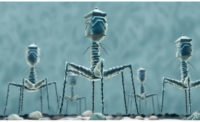Battle Against Campylobacter
By Rama Nannapaneni
Mississippi State University
Of all the foodborne bacterial pathogens, Campylobacter is the most common cause of human foodborne gastroenteritis in the United States and in the world. Campylobacter cells are Gram-negative, grow at low oxygen conditions and are uniquely spiral shaped and move fast with the help of flagella. Recent U.S. Centers for Disease Control (CDC) reports show that there are decreases in infections from 1996-2003 caused by Campylobacter (28 percent reduction), which is evidence of important progress toward the National Health Objectives and Healthy People 2010 objectives.
Poultry is the primary reservoir of Campylobacter spp. Prevalence rates of Campylobacter exceed 80 percent or more in commercially processed raw chicken carcasses in the United States and Europe. A large contamination of poultry carcasses still remains, with approximately 1 to 4.82 Log10 CFU/ml of Campylobacter load per retail raw-chicken carcass rinse.
With the introduction of the Hazard Analysis and Critical Control Points systems in the United States, poultry processors have been required to meet performance standards for Salmonella in their products. However, there are no processing standards for Campylobacter at the present time. In the past few years, USDA’s Food Safety and Inspection Services (FSIS) has been evaluating the need for the implementation of similar performance standards for Campylobacter spp. FSIS has not set a processing standard for Campylobacter (incidence or numbers) on raw or further-processed poultry products yet. However, FSIS is performing a new annual nationwide young-chicken microbiological baseline data-collection program that may provide the necessary information to establish such a performance (FSIS USDA Notice 31-07).
Using Baseline data, FSIS is in the process of defining the acceptable quantitative levels of Campylobacter and may soon develop rationale for the new performance standard for the Campylobacter for raw poultry products. At the present time, there is a general agreement by FSIS and National Advisory Committee on Microbiological Criteria for Foods (NACMCF) that the quantitative assay for Campylobacter in poultry is more informative than the qualitative (presence/absence) assay. However, FSIS has not clarified whether all species of Campylobacter or only some are used in the quantitative measure of Campylobacter. Such condition is due to the fact that there is no simple quantitative assay for highly pathogenic C. jejuni from that of other Campylobacter loads in poultry and meat products. Also, high-throughput molecular enumeration methods (such as polymerase chain reaction, or PCR) are not routinely implemented at present, therefore, FSIS is focusing on the selective culture-based direct plating method for enumerating Campylobacter loads recommended by NACMCF.
Antimicrobial resistance has increased substantially in Campylobacter over the past decade. Fluoroquinolone-resistant C. jejuni strains have been found to be ecologically competitive and persistent regardless of the antimicrobial usage. Effective strategies for decreasing the Campylobacter load will depend on integrated antimicrobial strategies during both pre-harvest poultry production cycle as well as improved antimicrobial rinses during processing. None of the routinely used current strategies have significantly lowered the prevailing high incidence rates of Campylobacter in poultry.
With the emergence of antimicrobial resistance amongst foodborne Campylobacter spp., it is critical to find alternative strategies that do not use antibiotics during the growth phase of poultry production cycles. In some recent laboratory studies, naturally occurring citrus-based antimicrobials were found to be highly effective against inhibiting the growth of pathogenic C. jejuni and C. coli. Such new natural antimicrobial strategies are yet to be tested for their efficacy during poultry production, processing and during commercial packaging steps.
While both industry and regulatory agencies are constantly looking for new ways to fight against Campylobacter, one important final step in preventing campylobacteriosis rests in the hands of consumers, through adequate cooking of raw poultry products prior to consumption. Campylobacter is highly heat-sensitive. Therefore, regardless of how tough Campylobacter is in its persistence in nature or on raw poultry products, Campylobacter can be easily destroyed during cooking step of poultry and meat products.
Rama Nannapaneni is assistant professor of molecular food microbiology in the Department of Food Science, Nutrition and Health Promotion at Mississippi State University.

Report Abusive Comment